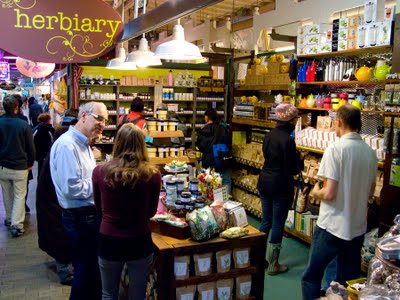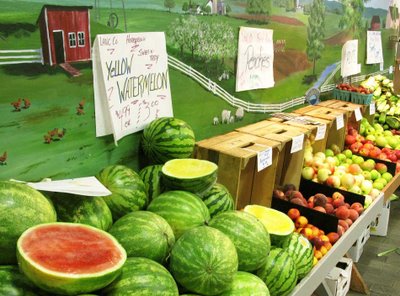Saturday, February 27, 2010
The Herbiary opened for business Wednesday at the Reading Terminal Market, just in time for the Flower Show. They specialize in medicinal herbs, tinctures, essential oils, dietary supplements and other plant, and nature-based remedies. The Herbiary is located adjacent to Contessa's French Linens, across from the Cookbook Stall.
For years I've been looking at "Mountain Trout" displayed as filets at the Reading Terminal Markets' fishmongers, knowing full well they weren't trout, but not quite sure what they were. Down in Baltimore they call this "Lake Trout".
Today I noticed (at Golden Fish) a sign which identified them, parenthetically, as hake, which is a member of the cod family, as is its very close cousin, the Whiting, which is usually found hereabouts as Silver Whiting, but sometimes called Silver Hake, as if things aren't confusing enough.
All the varieties are interchangeable, as least as far as culinary purposes are concerned. All are suitable for frying, steaming, poaching and baking, though broiling or grilling would be too extreme for these delicate and very mild-tasting fishies. Hake are the most popular fresh fish in Spain, and take particularly well to parsley and potatoes.
In other seafood news, Golden Fish is carrying a new item, head-on shrimp, $7.99/pound. You could probably save a bit by walking over to Chinatown, since that's where Golden procures these formerly frozen farm-raised crustaceans from China.
Nobody asked me, but . . .
Why is farm-raised striped bass more expensive that wild striped bass, a.k.a. rockfish: $6.99 vs. $4.99 at John Yi.
In the event you're wondering, the King salmon at John Yi (and just abou anywhere else) is farm-raised from British Columbia. Like it's Atlantic cousin, it gets its color from feed.
The Produce News
Cucumbers galore at O.K. Lee, including two seedless (or nearly so) varieties: Japanese and English. The former are a buck for what appears to be a one-pound bag with about six of the five or six-inch cukes. The latter are two 16-inches for a buck.
OKL also has bags of green seedless grapes for a buck (a tad more expensive if on trays) and Hass avocados at 49-cents apiece (essentially the same price as Iovine's where they're two for a buck).
Another cucumber-like item normally found in Chinatown made its way to the RTM today: Iovine Brother's had Bitter Melon sitting next to the bell peppers, $2.99/pound.
Labels: bitter melon, cucumber, fish, golden, grapes, hake, iovine, ok lee, reading terminal market, rtm, shrimp, striped bass
Tuesday, February 23, 2010
The bargain of the week at Iovine Brother's Produce at the Reading Terminal Market appears to be lettuce.
Displayed front and center today were four varieties, each priced at two heads for a buck: Romaine, Green Leaf, Red Leaf, and Iceberg.
Although there's nothing wrong with a nice green salad, or a wedge of Iceberg with freshly made blue cheese dressing, it seems a good time of year to consider making Lettuce Soup. Cooked with some potato, one of more members of the allium family, and herbs, pureed and finished with a wee bit of butter, it's a fitting dish for winter, but a relief from root vegetables.
The Chilean grape harvest is approaching peak, and prices have dropped accordingly at Iovine's. One-pound clamshells of white seedless were available for a buck, tray-packed bunches for $1.49. Iovine's also had a variety labeled "Tomcat", but at $5.99/pound I passed them by. They are a variety of Muscat, one of the original grape varieties, and are sweeter than the norm.
It might be a good week for making guacamole. Iovine's also featured ripe and ready avocados (don't store them for long!) at 50 cents apiece. Limes were a reasonable four for a buck.
Over to the fishmongers. I haven't done a taste comparison, but Golden Fish has been selling "dry" scallops for $13.99, a considerable savings versus John Yi, where they sell for $17.99. Golden also has something I haven't seen at the other stalls: unagi, Japanese barbecued eel, $6.99 a pack.
Labels: avocado, golden fish, grapes, iovine, john yi, lettuce, reading terminal market, rtm, scallops, unagi
This being the winter doldrums, at least as far as fresh produce is concerned, my posts normally decline in quantity this time of year. This winter of near-blizzards is no exception, but the weekend before last caused me to alter my opinion, slightly, about a root vegetable I've regularly slighted: the humble rutabaga, a.k.a. Swede, a.k.a. Yellow Turnip.
The cause of my conversion is the delicately-flavored smallish specimens which have been on sale at the Reading Terminal Market's Fair Food Farmstand since the onset of winter. They hail from Vermont's Deep Root Organics. a cold storage coop on the northern climes of the Green Mountain State.
Along with parsnips from the same coop and supermarket "baby" carrots, they became the vegetable component of a Valentine's Day dinner I composed for my Valentine, who has always held the rutabaga in high esteem (must be her Scandinavian heritage). I cut the veggies into half-inch dice, tossed with a minimum coating of olive oil, along with a little thyme, salt, pepper, a scant teaspoon of sugar (to encourage browning) and roasted them in the oven.
To my amazement, the rutabaga actually tasted good! Maybe it was the sugar, maybe it was the roasting, since my previous encounters with rutabagas had always been simply mashed with butter. But these roasted rutabagas had a more subtle countenance than the mash, so that the flavor note I previously found offensive became appealing. Will wonders never cease?
The veggies accompanied filet mignon, a cut she enjoys but I rarely prepare for myself because of its lack of flavor compared to other cuts of steaks, though its tenderness is always to be admired. This beef came from Harry Ochs, and the combination of high quality beef and the method of preparation made it a hit, even with me. I simply seared it in a pan, three minutes on a side over medium high heat to get a nice char (not disturbing the meat except once, to turn turn it), then finished it off in a 450F oven for another four minutes for medium, my Valentine's preferred doneness. While it rested on a warm platter under foil, I made a pan reduction with cream sherry finishing with a small knob of butter. Although I prefer my steaks rarer, this retained just enough pinkness to remind it came from a living thing, and had great flavor.
Dessert was a sampling of truffles from Neuchatel Chocolates of Oxford, Pennsylvania, every bit as good as any truffle we've had. The creations from Swiss chocolatier Albert Lauber can be had at the Pennsylvania General Store.
Labels: cheese steaks, harry ochs, iovine, neuchatel chocolates, reading terminal market, rtm, rutabaga
Saturday, January 23, 2010
 When William Bligh (left) set sail on the HMS Bounty to the South Seas to collect breadfruit trees, his goal was to bring them to the Carribean to see if they could become a crop suitable for feeding slaves working sugar cane fields and refineries. You don't have to resort such extreme measures. They're available at Iovine Brothers Produce at the Reading Terminal Market for $1.99 a pound.
When William Bligh (left) set sail on the HMS Bounty to the South Seas to collect breadfruit trees, his goal was to bring them to the Carribean to see if they could become a crop suitable for feeding slaves working sugar cane fields and refineries. You don't have to resort such extreme measures. They're available at Iovine Brothers Produce at the Reading Terminal Market for $1.99 a pound.When one of the cook's at the Down Home Diner, a native of Trinidad, spotted them he quickly grabbed a few for roasting.
Despite its name, breadfruit is treated as a vegetable, not a fruit. The fibrous flesh, a staple in many tropical regions, can be roasted, baked, fried, steamed or boiled. Its taste and texture is loosely compared to potato or fresh-baked bread. In the Caribbean it is sometimes mashed with bacalao, olive oil and cooked onions. The seeds are also edible, and are likened to chestnuts in flavor and texture.
Although primarily used as a substitute for other starchy vegetables, it can also be used as a pie filling, though usually in combination with chocolate, pumpkin, sweet potatoes, sweet yams or taro.
The National Tropical Botanical Garden's website offers a number of recipes here.
Labels: breadfruit, iovine, reading terminal market, rtm
Saturday, January 16, 2010
A one-pound pack of strawberries for $9.99? Get used to it, at least for the next month or so.
The freeze in Florida and heavy rains in California are taking their toll on off-season winter produce. At Iovine Brothers Produce at the Reading Terminal Market today, the clamshells of Driscoll California strawberries were as expensive as I've ever seen them, $9.99. In late January and into February, Iovines frequently features strawberries from Plant City, Floriday, at bargain prices, typically $1 or $2 for a one-pound pack. Don't expect to see them anywhere near that price this winter. The Florida freeze hasn't yet impacted citrus prices but Vinnie Iovine expects they'll start heading north over the next week or two. He's even, for all practical purposes, out of leeks! About one-third of Florida's total winter fruit and vegetable production has been lost to the freeze.
The Dutch and other growers will take up some of the slack for some of the items, but they'll be priced to reflect the shortages caused by natural phenomena. Chilean fruit isn't expected to be heavily affected, since most of what they grow isn't duplicated during winter in California and Florida, but even the Chilean grapes have been dear, with better quality bunches selling for upwards of $4.99, though some smaller Chilean seedless grapes could be had for $1.99 today.
Vinnie expects his display bins of specials will be heavy on the root vegetables, rather than fruit, in coming weeks.
Supply, demand and inventory hold their sway over fish prices, too. At John Yi today the mackeral was selling for $1.99, vs. $2.49 yesterday -- they gotta move it before it becomes too old. Meanwhile, Golden priced mackeral today at $2.99. A similar price discrepancy could be found in sardines: $4.99 at John Yi and $1.99 at Golden; there was no discernable difference to my eye in size and quanity between the two fishmongers.
Crowds were thick at the RTM at mid-morning today. Partly that was due to the opening of the home show across the street at the Convention Center, but also because of a soccer convention that ends today. Yesterday, DiNic's ran out of roast pork by 4:30 p.m., which Joe Nicolosi attributes to the soccer crowd.
Labels: citrus, fish, fruit, golden, iovine, john yi, reading terminal market, rtm, strawberries
Friday, January 15, 2010
 Yes, We Have No Beignets
Yes, We Have No BeignetsBill Beck has 86'd beignets at his Reading Terminal market counter, Beck's Cajun Cuisine.
Reason: They've been awful.
Although my first sampling found them just fine, with a reasonably light texture, he's had problems since. In two subsequent tastings, the outside was impossibly crunchy and the interior hollow. Beck's tried to figure out what's wrong, but for the time being decided to forget about them. And all this after spending bucks on a heavy-duty mixer whose sole purpose was to prep the dough.
So, once again, the Reading Terminal Market will have to wait for a superior sweet fried dough.
Labels: beck's cajun cafe, beignets, reading terminal market, rtm
Saturday, November 21, 2009
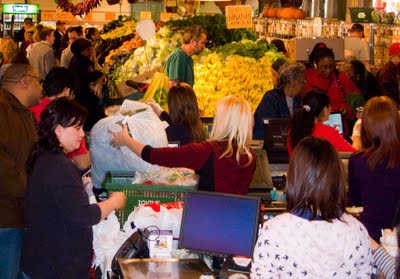 Side Dish Bargains
Side Dish BargainsThe aisles were crowded at Iovine Brother's Produce at the Reading Terminal Market this morning as shoppers sought veggies for their Thanksgiving tables. Once you managed to fight your way through the aisles, however, checkout was a snap: Jimmy and Vinnie Iovine rigged up a couple of additional registers, so there were an even dozen cashiers working.
Once reason for the crowds might have been the prices. White utility and Idaho potatoes, in five-pound bags, would set you back only $1.99. A 10-pound bag of non-Idaho russets were an even better deal, $2.99. Red potatoes were a relatively pricey, but still thrifty, $2.99 for a five-pound bag.
Onions were a good deal, too, at a buck for a two-pound bag (red or yellow). Three-pound bags of carrots were selling for two for $3. The green beans for your classic canned fried onion-topped casserole, however, were $1.99/pound, about twice as much as you'd pay at peak season. If you like some bay leaf in your stuffing, tray packs of fresh leaves were $1.99.
Among the non-Thanksgiving produce, limes have tripled in price, to 3 for $1. Hass avocados were two for $1.49.
Labels: iovine, produce, reading terminal market, rtm
When winter arrives, I'm a big fan of frozen fruit, particularly berries. Nothing like some tasty, sweet and tart blackberries to mash up with a full-fat yogurt for breakfast.
With its recent expansion the Fair Food Farmstand at the Reading Terminal Market has more room in its freezers, so it's added another fruit to its small frozen selection: strawberry puree. The one-pound packs from Green Meadow Farm, a delicious looking red, are priced at $5. I haven't tried them yet, but I can't imagine theyd be anything but excellent.
Another summer fruit you can enjoy in winter are peaches. Canned peaches from Three Springs Fruit Farm (one of the vendors at Headhouse) can also be found at Fair Food; I went through a few cans last winter and thoroughly enjoyed them.
Labels: fair food farmstand, fruit, peaches, reading terminal market, rtm, strawberries, three springs
Sunday, November 15, 2009
The black dirt farm country of Orange County, New York, is ideal for growing onions. And Iovine Brothers Produce has them at the Reading Terminal Market. Yesterday Iovine's was selling two-pound bags of either yellow or red onions from that growing area for $1 a bag.
Also spied at Iovine's: Chilean avocados, two for $1.49; Brussels sprouts stalks, $1.99; red bell peppers, $1.49, which was less expensive than the green, orange or yellow bells, all $1.99; limes continued to be obtainable at a dime apiece.
Brussels sprouts stalks (they called them "trees" at Iovines) were available from some of the other farm vendors: $7.50 at Fair Food, $4.95-$5.95 at Earl Livengood's.
Fair Food featured what might be the last of the seasons local tomatoes, pints of organic cherry tomatoes for $4.50. The poblano peppers, $4.50/pound, looked good.
At Kauffman's Lancaster County Produce celery stalks were $1.99 ($2.49 for hearts). Livengood's celery and celeriac were both priced at $3.95/pound.
Labels: fair food farmstand, iovine, kauffman, lancaster county produce, livengood, reading terminal market, rtm
Yesterday's Forgotten Foods Festival at the Reading Terminal Market opened my eyes, and tastebuds, to some old-time flavors of Philadelphia and envir0ns. By the time I left the market shortly after 11 a.m. (the festival began an hour earlier), center court was crowded with regular shoppers, the normal passel of tourists, foodies drawn by the festival, and early Christmas shoppers attracted by the Philadelphia Museum of Art's annual crafts show across the street at the Convention Center.
A particular revelation to me was the Cape May Salts, an oyster brought back from oblivion a few years ago by Atlantic Cape Fisheries, a Cape May-based company. Once upon a time the Delaware Bay was teeming with oysters, hence the proliferation in the late 19th and early 20th centurys of oyster houses in Philadelphia, once as common as today's pizza parlors, according to Atlantic Cape. In the 1950s, disease wiped out the commercial oyster industry in Delaware Bay. It took the development of disease-resistant oysters by Rutgers University and Atlantic Capes to reestablish the commercial oyster in Delaware Bay. (The Cape Mays were dispensed by the Fair Food Farmstand's Forgotten Foods stall.)
Oysters from New England, the Northeast and Mid-Atlantic are traditionally briny, but the Cape May Salts deserve their adjectival moniker more than most. The salt flavor is pronounced and delicious; these would be perfectly accompanied by a local lager, say Yuenglings or Yards.
Oysters also appeared in one of the offerings from Pearl's Oyster Bar. I've haven't eaten at Pearl's recently because previous times I'd eaten there I was disappointed: the snapper soup was way too gloppy, and the breading on the fried seafood way too doughy. That wasn't the case with what I sampled yesterday. The large, Chesapeake-style oysters in the Oyster and Chicken Salad sample was more modestly breaded and perfectly fried, the chopped chicken bound with as little mayonnaise as possible. Put them together and you've got a ying-yang food with much appeal. The little sample of Snapper Soup also was unlike what I tried previously. It might have had some corn starch to give it body, but not much. Based on these two items I'm going to give Pearl's lunch counter another try.
Old style oyster crackers -- Old Trenton Crackers -- were the media used for conveying the freshly grated horseradish offered by Hershel's East Side Deli. The pungency of the fresh grated variety is head and shoulders over the jarred imitators. Because Hershel's used an electrically-powered mechanical grater, it lacked the frisson provided by the knuckle skin that found its way into the condiment that accompanied our gefilte fish during the Pesachs of my youth.
Another revelation could be found in the black walnut cupcakes sold by Fair Food. The cupcakes, made by Flying Monkey Patisserie, used black walnuts from Green Meadow Farm, one of Fair Food's suppliers. Topped with a cream cheese-buttercream frosting, these are among the best tasting "adult" cupcake I've ever sampled.
Another dessert offered was teaberry ice cream from Bassetts. While the small cup I tasted was as creamy and rich as any produced by Bassetts, the teaberry flavor (one I always enjoyed in gum) failed to impress as an ice cream. The flavor, much like wintergreen mint, was too bubble-gummy for me, especially with its neon pink color.
The only other item I tried as the festival was the corn pudding offered by Pennsylvania General Store, made with Copes corn, a dried, toasted Pennsylvania Dutch staple. Cooked to a bread-pudding like consistency and accented with what I took to be little bits of dried fruit, this was a wonderful combination of savory and sweet. It would make a fine addition to anyone's Thanksgiving table.
Among the items I missed was the liverwurst from S&B Meats and Down Home Diner's catfish on waffles, served by Jack McDavid. If anyone can report on those items, or any other I've missed, please do!
Labels: cape may salts, forgotten foods, reading terminal market, rtm, snapper soup, teaberry
Sunday, November 08, 2009
At least some merchants and the Reading Terminal Market have seen business fall off dramtically due to the SEPTA strike.
One of Iovine Brothers Produce's managers said volume was off 40 percent. On top of that, he and fellow managers had become a de facto taxi service, driving employees to and from work.
Other merchants saw lesser impacts. Over at the Fair Food Farmstand, while business was off a little, it wasn't devastating.
Labels: iovine, reading terminal market, rtm, septa
I'm only about a quarter into this book dedicated to the Jewish deli, but it is fascinating. Although author David Sax may have omitted reference to your favorite deli, anyone who enjoys a good pastrami sandwich or plate of kishke will say a b'rucha for this book.
I purchased the book last Tuesday at a signing in connection with Sax's appearance in the Free Library of Philadelphia's author series. Coincidentally, Tuesday was National Sandwich Day, the birthday of John Montague, reputed to be the inventor of the sandwich. (A blatant lie.)
In his talk, Sax outlined the two primary reasons why the Jewish deli is in such serious decline (from a couple thousand in the early part of the century in New York City to maybe a couple hundred today).
The first reason is simple economics. The traditional foods served by the deli have very high material costs. The margin on that $9 or $14 pastrami sandwich will be a buck at best. Add in high rents (especially in Manhattan) and labor costs and you've got a business challenge of the first order.
The second reason -- and the one Sax spent most of his time discussing -- is culture. He quickly touched on a variety of cultural reasons for the deli's decline (generational change, changes in food tastes, etc.), but I found one particularly interesting: No homeland for keeping the tradition alive. For example, the reason why Italian restaurants are still going strong, even though changes in U.S. immigration law largely shut off the Italians as much as the Jews in 1920, is that there is still an Italy with a thriving, evolving food culture. Same goes for the various Asian cuisines and just about any other ethnic cuisine you can think of. Not so Ashkenazi Jewish cuisine: the Holocaust wiped out the Ashkenazi Jews of Europe and, with it, the natural homeland of their cookery.
That's not true of the style of Jewish cuisine that has most recently taken root and thrived in America, Israeli/Middle Eastern cooking. Falafel stands are ubiquitous, as Israelis migrate to the U.S. and open restaurants offering their home cooking, as reinterpreted here in America. Because there is an Israel with its own cooking traditions (albeit, adapted from Arabic cultures, just as Ashkenazi cooking adapted from Polish, Germany, French and other european cultures), there is a living base from which to grow.
In his Philadelphia talk, Sax offered a number of possible solutions -- including his belief that delis should eschew buying finished corned beer and pastrami from the large processors, like Hebrew National (a unit of Conagra), and instead cure their own meats and make everything they can on premises. Since he was speaking in Philadelphia, he singled at Hershel's East Side Deli in the Reading Terminal Market as a fine example. (That's where he lunched.)
Sax is definitely going to be a big hit at all the pre-Hanukah Jewish Book Fairs around North America. The fact that he's from Toronto and has a passion for Montreal smoked meat, you shouldn't against him hold.
David's web site: Save the Deli
Labels: david sax, deli, hershels, reading terminal market, rtm, save the deli
Sunday, November 01, 2009
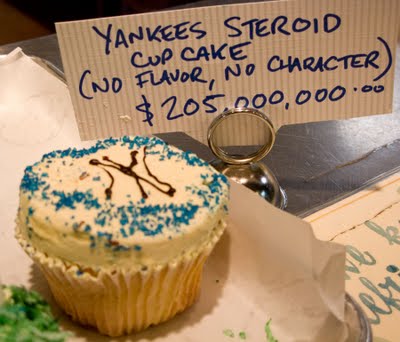
It's a high-priced cup cake, as befitting the New York Yankees. Rebecca Michaels, proprietor of Flying Monkey Patisserie at the Reading Terminal Market created this goodie for any New Yorkers visiting for the World Series who had cash to burn.
Labels: cup cake, flying monkey, reading terminal market, rtm
Forgotten foods of the region will be the focus of a festival at the Reading Terminal Market on Saturday, Nov. 14, from 10 a.m. to 4 p.m.
A number of merchants will be preparing some of these foods from our past, and they'll all be available for tasting at reasonable cost. (You'll probably buy tickets at a central point, then exchange the tickets for the tastes.)
Among the featured foods:
- Copes Dried Corn, Wilbur Buds (the original from which Hershey derived his kisses), and Buttercreams from Pennsylvania General Store.
- Fried Catfish and Waffles, Pepperpot Soup from the Down Home Diner.
- Pepper Hash from AJ's Pickles.
- Fried Oysters from Pearl's served with Chicken Salad (probably from Hershel's).
- Snapper Soup from Pearl's.
- Cape May Salt Oysters, Cranberries and Black Walnuts from Fair Food Farmstand.
- Fresh Grated Horseradish from Hershel's.
Dominic Spataro, whose sandwich shop has been a presence at the market for decades, said fresh grated horseradish brings back fond market memories for him. Nearly half a century ago a merchant named Franklin Field made it on premises for sale at the predecessor to today's Spice Terminal, where he also offered fresh grated coconut. His granted both by hand on a tool used by carpenters to bevel latticework, wearing a leather apron to protect himself from injury Another of Field's products that was quite popular was Irish dulse (seaweed). The tradition continued when Field's stall was taken over by Harvey Riley, who ran it until it closed in the late 1970s. The spice shop was located near where Iovine Brothers Produce stands today.
Poses: The Commissary At Home
Steve Poses, remembered by many as one of the movers creating Philadelphia's Restaurant Renaissance in the 1970s and 1980s through his Commissary restaurant, has spent his efforts since then with his catering business. Now he's published a book about home entertaining, At Home: A Caterer's Guide to Cooking & Entertaining.
Poses will be in the Piano Court next Saturday, Nov. 7, from 11 a.m. to 2 p.m. promoting the book and its companion web site and sharing his expertise and passion for home entertaining. He’ll present mini-courses designed to help plan a delicious and stress-free Thanksgiving. The book, usually sold only online (www.athomebysteveposes) will also be available for purchase.
Labels: forgotten foods, poses, reading terminal market, rtm, spice terminal
There will be a bit of show and tell when author David Sax visits the Free Public Library Tuesday evening to promote his book, Save the Deli. A couple of local delis will be providing noshes, including pastrami of Hershel's Deli of the Reading Terminal Market. The program is free and begins at 7:30 p.m. at the Central Library, 19th and Vine.
Labels: deli, hershels, reading terminal market, rtm
Saturday, April 25, 2009
The Cost of Progress
Few ever noticed it, but the background to L Halteman’s fresh produce shelves, a rustic depicting of Lancaster County farming. came down when Iovine Brothers Produce consolidated most of its prep operations last month.
The mural was no great shakes as far as art goes, and it certainly wouldn’t be added to any museum’s collection of American folk art. Still, it was a nice little touch that added to the Reading Terminal Market’s eccentricity.
On the plus side, it gives Halteman’s stall greater visibility.
Labels: halteman, iovine, mural, reading terminal market, rtm
Friday, February 20, 2009
It seems my earlier report that the shad at John Yi's were harvested from Southern U.S. rivers was mistaken. According to the signs, these comes from European waters. Further research shows that there are two species of European shad inhabiting eastern Atlantic waters from Morrocco north to Norway, though the commercial shad fishery is centered in the Gironde-Garonne-Dordogne basin of France.
Although these fillets, whole fish and roe sets looked fine, you're probably better off waiting for the local run, which arrives in late April and early May. Or visit the annual Lambertville shad festival, scheduled this year for April 25 and 26.
Labels: john yi, lambertville, reading terminal market, rtm, shad
Saturday, February 14, 2009
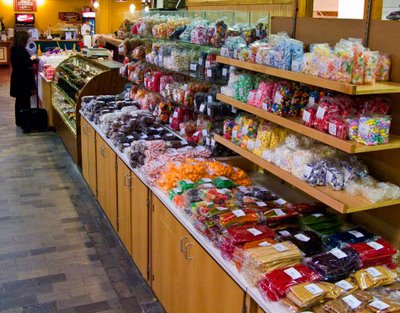 No Fresh Pretzels!
No Fresh Pretzels!At least temporarily, as Fisher's has demolished its existing stand in order to build a new one, which should be open by Flower Show, which begins Feb. 28. When it reopens, Fisher's will be strictly a candy vendor. In the meantime, Fisher's is selling candy in the spaces formerly occupied by Dutch Country Meats and Every Day Gourmet, as shown in the photo.
Across the aisle, Miller's Twists is well along on construction, anticipating opening Feb. 25, which is when you can satisfy your fresh-baked pretzel addiction. (In the meantime, you can indulge on a fine example of street pretzel sold at the Pennslylvania General Store.) As previous reported, Miller's has bought Fisher's pretzel and ice cream business and is moving it to the west side of the Green Court seating area.
Right now seating is scarce in the Green Court, but will be restored to pretty much the previous level when the Fair Food Farmstand makes its move to the 12th Street side in May.
Fair Food Funding Gain
Fair Food is closing in on its funding needs for the move, thanks to a $50,000 state grant being arranged through State Rep. Dwight Evans, who just happen to chair the House's Appropriation Committee.
Members of the Fair Food staff attended Pennsylvania Association of Sustainable Agriculture Conference in State College earlier this month, and in addition to attending various workshops also exhibited a "mini" farmstand. One of the goals was to find new farmers to let them know how the Fair Food Farmstand can help in selling their products.
Stands To Remodel
Lancaster County Dairy needs more space, Old City Coffee's adjacent stand is a jury-rigged mess. Solution: Old City reduces its footprint in a redesigned stall, making the operation more efficient (particularly important on a morning like today, when attendees and exhibitors from the crafts show at the Convention Center caused long lines). And Lancaster County Dairy gets the space it needs.
Labels: fair food farmstand, fishers, lancaster county dairy, millers twists, old city coffee, reading terminal market, rtm
Shad from Southern rivers appeared at John Yi's last week. Today they were selling for $3.99 (buck), $4.99 (roe) and roe sets were commanding $7.99. Local shad don't appear in the Delaware until May.
Based on how good it was a few weeks ago, I bought some haddock fillet at $7.99. I'll pan fry it tonight, perhaps in a panko crust.
More About Citrus
Or, at least, price reports from Iovine Brothers at the Reading Terminal Market.
The prices have held relatively steady except for a whopping reduction in the cost of limes. For the past week limes have been selling for a dime apiece. With Hass avocados under a buck (89 cents), it's once more guacamole time.
On to the other citrus:
- Honeybells, small 8 for $1
- Honeybells, large 2 for $1
- Temple oranges, 4 for $1
- Cara Cara oranges, 5 for $2
- White grapefruit, 89 cents
- Jumbo red grapefruit, 3 for $1
- Small ruby grapefruit, 4 for $1
- Navel oranges, 3 for $1
- Mineola oranges, small 4 for $1
- Mineola oranges, large 2 for $1.49
- Jumanji oranges, 2 for $1.49
- Juice oranges, 4 for $1
Oh, and black truffles, $300/pound, with the two packs I saw priced at $18 apiece. Makes a heck of an omelet.
Labels: citrus, fish, fruit, iovine, john yi, produce, rtm
Tuesday, January 20, 2009
A steaming bowl of chili or cauldron of soup seems essentially in cold weather. Fish chowder also satisfies that craving for me.
I went with a piece of haddock from John Yi's Saturday. Since I'm the only one in the house who enjoys this New England classic, I only used about a quarter pound of filet. A lot of folks think New England chowders have be creamy and thick. They don't. IMHO, whole milk allows the flavor of the fish to come through best.
I start out by gently sautéing in bacon fat a small onion, a stalk of celery, and half a carrot, all diced to about one-quarter inch. Once they turn translucent I add a medium diced potato, and gently sauté for about 10 minutes. Next comes about a cup of stock (I used vegetable stock made primarily from last fall's red celery from Tom Culton of Headhouse Square, though either fish or chicken stock would work very well) and a cup of milk, which simmers the veggies for another 10 minutes. By this time the potatoes are just about done, so it's time to add the fish (cut up into spoon-sized pieces), salt and pepper to taste, and thyme, dried or fresh, maintaining the pot at a simmer. After five minutes add a tablespoon of butter -- don't stir, just let it melt atop the liquid. By the time the butter adds its yellow sheen, the fish is probably cooked through. Once in the bowl, I top the chowder with fresh chopped parsley. To accompany, I used the last of my precious stock of Crown Royal crackers, a Maine favorite which has been discontinued by Nabisco, but OTCs would work well, too. Saltines and oyster crackers just don't have the necessary heft for those soup.
If you don't like plain white fish, no reason why you can't use shrimp, lobster, scallops or clams.
That filet of haddock at John Yi's in the Reading Terminal Market set me back $7.99/pound, which was also the price of the flounder. Fluke was $9.99. It was also one of those weeks where wild striped bass cost less than its farmed-raised cousin (a striped bass-white bass cross), $4.99 vs. $6.99 for whole fish. Boston mackeral has made an early appearance (it's strongest runs start in the spring), with prices ranging from $1.49 to $2.59, depending upon size. Medium-sized porgies were $2.99, cod filet (which would be an other good choice for chowder) $9.99, black sea bass $5.99.
A Wan's Seafood, the haddock would have set me back $11.99/pound. Whole striped bass as $3.99 (though the quality didn't look quite as good as at Yi's), though the filets were appealing at $9.99. Wan's was the only RTM fishmonger still selling sardines, $3.99.
Golden Fish's new cases displayed wild striped bass at $4.99, whole black sea bass at $4.99, Bronzino (another sea bass, farm-raised in Europe) for $7.99 on the bone, and particularly good looking, fat mackeral at $2.99.
Labels: fish, golden, john yi, reading terminal market, rtm, wan
Also, the two businesses which will share the former Dutch Country Meats stall are S&B Meats (the butcher) and Barb & Suzy's Kitchen.
Labels: barb and suzy, butcher, millers twists, pretzels, reading terminal market, rtm, s and b
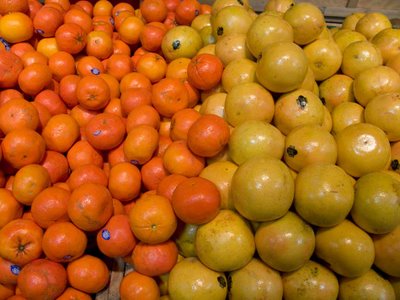
I counted more than a dozen varieties of citrus fruit at Iovine Brothers Produce Saturday morning. Here they are, along with prices:
- Temple oranges 5/$1
- Jumanji oranges 2/$1.49
- Blood oranges 4/$1
- Tangelos 5/$1
- Tangelos (3-pound bag of about 11) $2.99
- Tangerines 10/$1
- Ruby grapefruit (medium) 3/$1
- Red grapefruit ( large) 2/$1.49
- Navel oranges (California) 2/$1.49
- White grapefruit (medium) $2/1
- Honeybells 2/$1
- Cara Cara red oranges 2/$1.49
- Navel oranges (Sunkist medium) 3/$1
- Juice oranges (Florida) 4/$1
- Red navel oranges (Florida) 4/$1
If organic and small grower citrus from Florida is one of your requirements, you might consider stopping by the Fair Food Farmstand and paying a premium. Navels and Cara Cara red oranges were selling for $1.50 apiece, Sunburst tangerous 95 cents each. A premier juice variety, Hamlin, priced at 60 cents apiece. Red grapefruit were $2.75.
Labels: citrus, iovine, reading terminal market, rtm
Jonathan Best, the new fancy foods grocer at the Reading Terminal Market, will celebrate a grand opening next Tuesday. Jan. 27. The festivities include a raffle for "a weekend getaway in Chestnut Hill," where the business's main store is located. Also on the agenda: music from a Beatles cover band and soup samples. The celebration will be celebrated from 11:30 a.m. to 3:30 p.m. The store will donate 20 percent of the day's proceeds to Project H.O.M.E.
Labels: jonathan best, reading terminal market, rtm
Sunday, January 18, 2009
When Charles Giunta opened his Giunta's Prime Shop at the Reading Terminal Market his goal was to offer strictly organic or hormone-free meats. Though his signage suggested he'd be carrying USDA prime grade meats, he did not.
Now, Charles' products happen to be of excellent quality; I think his wet-aged beef, particularly the steaks, are about the best value you can find in red meat protein.
But the signs are misleading, and only a portion of the beef he carries is hormone-free, let alone organic. You have to ask whether a particular cut is hormone-free before you buy it, and the staff is not uniformly informed. Although I prefer hormone-free meats, I don't have hard-and-fast rules about it – if the beef tastes good. But I don't think he signs should suggest otherwise.
As for the "Prime" moniker, while that is also deceiving, I don't have as much of a problem. When USDA changed its grading standards more than 20 years ago, the difference between Prime and Choice became a lot fuzzier, as far as I am concerned. There's plenty of Prime out there that isn't, and, likewise, it's not that difficult to find Choice that tastes like Prime. And I won't even get into how most of the prime rib roasts (more properly called standing rib roasts) sold in this country are not Prime grade beef.
Likewise, only some of Charles' poultry products are hormone-free organic. He initially carried a lot of Eberle product, but now he focuses on Bell & Evans, which is a natural bird, i.e., no additives, non-therapeutic antibiotics or growth hormones. The all-natural ducks from Joe Jurgielewicz & Son of Shartlesville, about half an hour north of Reading, are superb.
When I recently asked Charles about this issue, he observed that he simply couldn't have survived on just organic and natural meats because they are more expensive; his customers just didn't purchase them in high enough quantities to justify basing the business on them. While there are a few customers who will pay $18 or $23 for a steak, the vast majority of shoppers, including those at the Reading Terminal Market, look for the least expensive product that still offers reasonable quality.
A tip of the hat to fellow blogger Gaetano of Philly Market Cafe for refocusing my attention on the signage discrepancy.
Labels: butcher, giunta, meat, reading terminal market, rtm
Wednesday, January 14, 2009
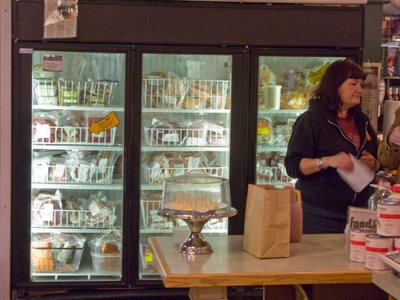 Case Study: Old
Case Study: OldWhen the Fair Food Farmstand moves to its new location within the Reading Terminal Market sometime this spring, this old, recalcitrant freezer case will be replaced. A week ago Friday is went kaput, forcing FFF to sell it's contents (mostly meat) at half-price, much to the delight of shoppers. The few items that remained were donated to a local food bank. That's FFF co-manager Sarah Cain lamenting her cool problems.
Labels: fair food farmstand, reading terminal market, rtm, sarah cain
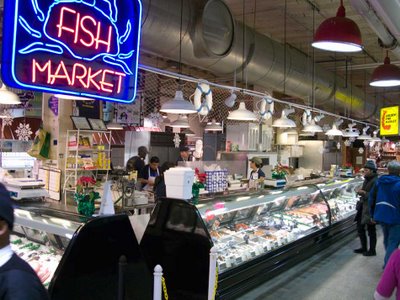 Case Study: New
Case Study: NewThe new cases at Golden Fish, one of three fishmongers at the Reading Terminal Market, have been in place for about a month. They make a big difference in how the product looks. Much more attractive than the old cold cases.
Labels: fish, golden fish, reading terminal market, rtm
Monday, January 12, 2009
I'm a sauerkraut fan, so I picked up a jar of Wills Valley Farm's fermented red cabbage at the Reading Terminal Market's Fair Food Farmstand a couple of weeks ago.
Straight out of the jar, I did not care for it. But when cooked . . . WOW!
I came to this conclusion after gently braising some German-style hot dogs in the red cabbage kraut. First I gently sautéed a medium onion in canola oil (butter would work, too) until just barely starting to turn golden, then I added the red cabbage, allowing it to cook covered for about 10-15 minutes. I had an old Asian pear, slightly shriveled, sitting in the crisper, so I peeled it and grated the pulp into the cabbage. (An apple is the usual addition, but none were in the larder.) Then I added maybe a quarter cup of water (if I had an open bottle of white wine, I would have used that), a couple of the foot-long franks, covered again and simmered low for another 10-15 minutes. Delicious, especially when served with a German-style mustard.
Labels: fair food farmstand, reading terminal market, rtm, wills valley farm
Saturday, November 29, 2008
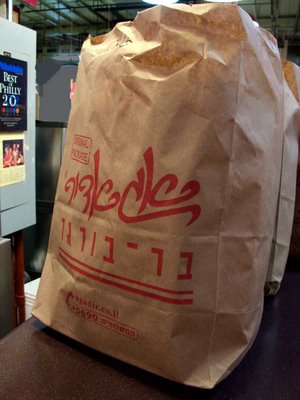 Italian Bread Bag?
Italian Bread Bag?Found this morning on the counter of DiNic's at the Reading Terminal Market: bags full of bread delivered from an Italian bakery, to be filled later in the day with roast pork, veal, sausages, roast beef, brisket, pulled pork, etc., etc., etc..
Not unusual, except for the printing on some of the bags. It's in Hebrew. Hard to explain how they came into the possession of Dante's, the bakery at 8th and Watkins that supplies DiNic's, other than the bag manufacturer had an overrun.
Still, the bags are suitable, since they advertise Agadir, small Israeli chain featuring burgers, but also roast beef, sausage (merguez and chorizo) sandwiches and an interesting array of salads and starters. And yes, you can get a cheeseburger: the chain is not kosher.
Labels: bread, dinics, hebrew, reading terminal market, rtm
Wednesday, November 26, 2008
Local TV stations were scheduled to cover the crush of shoppers at the Reading Terminal Market during their morning shows today. Hundreds line up before the doors open at 8 a.m. the day before Thanksgiving.
In addition to the Pennsylvania Dutch merchants who made an early showing this week at the Reading Terminal Market, Earl Livengood was also there Tuesday and Wednesday (today). Among the many autumn produce stalwarts at Livengood's were romanescue heads of diminutive size, perfect for two eaters.
Arctic char made its appearance at John Yi's this week. The filets are selling for $14.99. Char is usually farm-raised in Canada and Iceland, and is considered to be considerably more environmentally benign than salmon aquaculture. Char, a salmonid, is somewhere between trout and salmon in size and flavor. Expect more fish variety at the market as we approach Christmas.
This past weekend busted all sorts of records for market visitors, according to RTM GM Paul Steinke, with the highest attendance seen since the Flower Show. Much of it was driven by Philadelphia marathon competitors and visitors.
Labels: char, john yi, livengood, reading terminal market, rtm
Saturday, November 22, 2008
Over at the Reading Terminal Market, extra checkouts have been added at Iovine Brothers Produce for the holiday rush in an effort to keep those long lines moving.
Many of the Pennsylvania Dutch merchants, who are usually closed on Mondays and Tuesday, will be open on those days (as well as Wednesday) before Thanksgiving. Those planning to be open both Monday and Tuesday are AJ Pickle Patch, Beiler's Bakery, Hatville Deli, L. Halteman Country F0ods, and Lancaster County Dairy. In addition, the Dutch Eating Place, Dienner's BBQ Chicken, and the Rib Stand will be open Tuesday.
On the day before Thanksgiving, shoppers lined up waiting for the doors to open at 8 a.m. will be treated to free sample cups of coffee, courtesy of Old City Coffee. But it won't be at all the doors: just the 12th & Filbert entrance.
This morning 12 servers were working at Godshalls to push out those Thanksgiving birds, with a lineup of customers as soon as the market opened at 8 a.m. Expected even longer lines Wednesday.
Temporarily, at least, the Fair Food Farmstand has some extra display space, though no sales space. It's in the vacant stall formerly occupied by Everyday Gourmet and, before that, Andros. Squashes and other colorful items point the way to the the farmstand.
Speaking of Andros, he's the only retailer in town (2056 Pine) where you can acquire Leonidas chocolates, a high volume but nonetheless delicious Belgian praline manufacturer. As was once snootily explained to me by the proprietress of the old Belgian Chocolate House on S. 17th, "That's what you buy your domestic for Christmas." I'd do windows for that stuff!
The paperwork is moving along for a new pork purveyor who will move into the space formerly occupied by Dutch Country Meats. The stall has a long history of pork vendors dating back to Moyers and Charles Giunta (who now operates Giunta's Prime Shop). The butcher will sell the Stoltzfus Meats' product line, including scrapple and sausages as well as fresh pork. Not determined whether he'd handle deli products. In addition to its store in Intercourse, Stoltzfus sells at the Ardmore Farmers' Market, the New Castle Farmers' Market, and Beechwood Deli at the Fairgrounds Farmers' market, Allentown.
The Philadelphia Daily News' has selected the Reading Terminal Market as recipient of two of its People's Choice Awards: Best Farmers Market and Best Produce.
Labels: andros, fair food farmstand, godshalls, iovine, leonidas, reading terminal market, rtm
Saturday, November 15, 2008
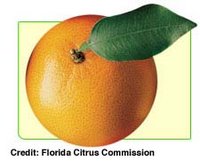 Florida juice oranges, Valencias and small navels were selling for 20 cents apiece. Sunburst tangerines continue to be eight for a buck. Among the grapefruits, larger pink and white grapefruits were two for a buck, small ruby three for a buck, larger Star ruby 99 cents apiece. Lemons and limes were both selling for 25 cents each, though O.K. Lee offered bags of limes (8 to a bag) for about half that price. In buying citrus, don't go by looks alone; instead, go for the fruit that's heaviest in the hand for its size.
Florida juice oranges, Valencias and small navels were selling for 20 cents apiece. Sunburst tangerines continue to be eight for a buck. Among the grapefruits, larger pink and white grapefruits were two for a buck, small ruby three for a buck, larger Star ruby 99 cents apiece. Lemons and limes were both selling for 25 cents each, though O.K. Lee offered bags of limes (8 to a bag) for about half that price. In buying citrus, don't go by looks alone; instead, go for the fruit that's heaviest in the hand for its size.Iovine's is also pushing imported berries. Half-pint clamshells of Argentine blueberries and Mexican raspberries could be had for a buck apiece. More attractive, to me, were the California brown figs, $1.99 for a box of about eight.
With Thanksgiving approaching, string beans are in demand, and Iovines featured bins of crisp fresh ones for 89-cents a pound.
Even though it's still autumn, John Yi must think it's spring. You could buy small whole shad there for $2.99/pound. In a few weeks we should start to see a wider variety of fish as Yi and the RTM's other fishmongers stock up for the holidays.
Labels: citrus, iovine, produce, reading terminal market, rtm
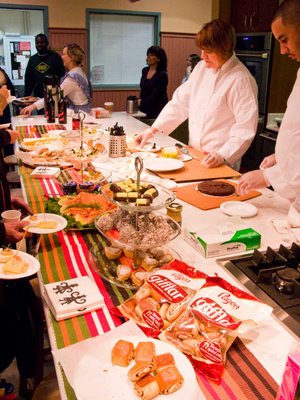 Ikea At The Market
Ikea At The MarketIkea showed off holiday food treats Thursday at La Cucina, the demonstration kitchen and cooking school at the Reading Terminal Market. Ikea staffers outfitted in blue-striped frocks lured customers in with Pepparkoker, a ginger snap-like cookie.
I tasted the gravlax, with various cheeses, meetballs and sweets also available to sample. Alas, I was disappointed in my search for, as Ulla would say, "many different herrings": not a single tidbit of Culpea harengus, the Atlantic herring species that finds its way into so many excellent Scandinavian buffets.
Labels: ikea, reading terminal market, rtm, swedish
Limited groceries, at a price
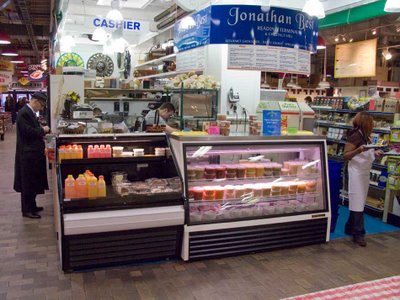
Jonathan Best opened last week in the spot formerly held down by Margerum's and the Natural Connection. The high-end grocer is a welcome addition to the Reading Terminal Market. The homemade soup selection looked inviting, the flavored spreads appetizing, and the chocolate bar selection downright sinful.
That's the good news. The bad news: it's not Margerum's.
The beauty of the old Margerum's store, which closed in 2001, was that if you needed a jar of Hellman's mayonaisse or a bottle of Heinz ketchup for a recipe, you could get it. You'd pay a bit more than at a supermarket, but not unreasonably so. That was in addition to all the wonderful variety of dried legumes Noelle Margerum stocked.
You can still buy mayonnaise or ketchup at Jonathan Best. But the mayo won't be Hellman's and the ketchup won't be Heinz's. The mayo will be some organic, high-end variety priced at $6.59 for a 16-ounce jar. The ketchup will be an $8.99, 11-ounce bottle of from Wilkins & Son of the U.K.
The problem, of course, is that a merchant can't make a living selling Heinz ketchup and Hellman's mayonnaise at the RTM: the margins aren't great, the volume too low. To make the rent (which is lower for grocers and purveyors than it is for the lunch stand vendors), a grocer has to do something more. That appears to be where Jonathan Best succeeds. I haven't tried the soups yet, though they look good and plenty of market visitors this week were trying the free samples being ladled out. I did taste one of the spreads (pumpkin), and it would be a perfect nibble with cocktails for the fall season. The chocolate bars (expensive, the cassis-flavored dark bar I purchased was selling at the equivalent of $37/pound) are excellent.
If you prefer to buy your spices jarred rather than in bulk, as at the Spice Terminal, Jonathan Best is for you. They've also got a larger selection of dried pastas than Salumeria. And the selection of fruit jams and preserves expands upon that available at the Spice Terminal.
Still, it would be nice to be able to buy some non-gourmet mayo for my tuna salad or ketchup for my burgers at the market. Maybe even a box of corn flakes I can used for oven-fried chicken!
Labels: jonathan best, reading terminal market, rtm
Monday, November 03, 2008
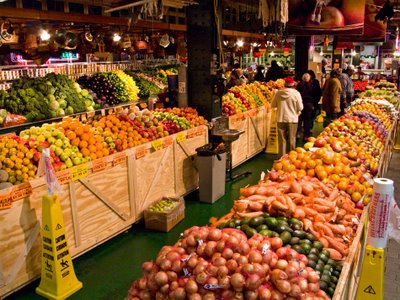 Iovine Brothers
Iovine BrothersRe-arranges
Once Again
Hardly a year goes by and Iovine Brothers Produce decides its time to play musical chairs with its Reading Terminal Market displays. It keeps customers and staff on their toes.
The net result of this year's re-arrangement is a much more open feeling. That was achieved by using lower level bins for the first two aisles, mostly containing fruits and featured veggies. The racks of dried fruits, nuts and other items was moved against the window wall along Filbert Street. The standard size display cases form the row between the window wall and the bins. The mushroom refrigerated cases now joins the other coolers along the Filbert Street windows nearest the checkout.
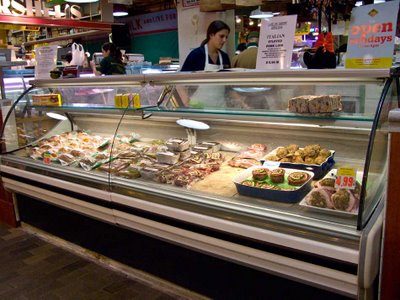 Another facelift could been seen at Harry Ochs, where a new case is home to prepared items (like stuffed flank steaks, stuffed pork chops, patés, etc.), making more room for raw meat in the main case. The big roast and steak subprimals, however, are now invisible in the walk-in refrigerator.
Another facelift could been seen at Harry Ochs, where a new case is home to prepared items (like stuffed flank steaks, stuffed pork chops, patés, etc.), making more room for raw meat in the main case. The big roast and steak subprimals, however, are now invisible in the walk-in refrigerator.As of Saturday, Jonathan Best was not yet open, but it appeared that all the cases and shelving was in place, just waiting to be stocked. I would expect they'll make every effort to open in advance of Thanksgiving.
With Rick's Steaks now departed, most of that space now serves as a seating area.
Labels: harry ochs, iovine, jonathan best, reading terminal market, rtm
Monday, October 27, 2008
Those same Griggstown Quail Farms Red Bourbon turkeys I mentioned in the previous post are also availalble through the Fair Food Farmstand at the Reading Terminal Market. And they are even less expensive! The Farmstand is charging $6.50/pound for the heritage birds. In addition, you can reserve a traditional turkey for $2.99 (naturally raised) or $$4.50 (certified organic).
For the rest of your Thanksgiving table, you can take advantage of Fair Food Farmstand's other offerings, including both common and unusual squashes and white and red cranberries.
Aaack! The Farmstand is still using the term "wildcrafted". Last spring it was used to describe fiddlehead ferns. In the FFF's most recent weekly newsletter they are promoting Hen of the Woods mushrooms "wildcrafted by Patrick Murphy". Wildcrafted is taken to mean the gathering of wild plants in a manner which causes no permanent harm to the environment or the species. The goal is laudable, the nomenclature deplorable, a grave abuse of the English language worthy only of the most depraved advertising copywriter. How about "sustainably-gathered" instead? Wild-crafted erroneously suggests Patrick created/raised/nurtured the mushrooms.
Oh, well. At least the newsletter no longer considers the Jonamac a heritage apple!
Labels: fair food farmstand, reading terminal market, rtm
Monday, October 13, 2008
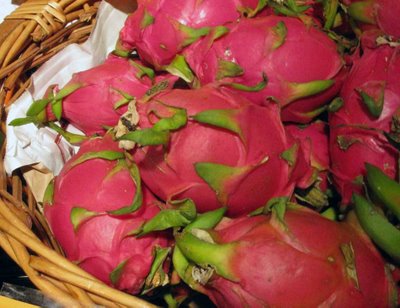
This could be found at Iovine Brothers Produce Saturday at the Reading Terminal Market. The fruits, about four or five inches long, reminded me of cactus pears (a.k.a. prickly pears). Although one of the Iovine managers told me they are similar in taste (and structure, with tiny seeds mixed in with the flesh) to kiwifruit, some Googling uncovered the fact that these Dragonfruit (more properly called Pitaya) are, indeed, the fruit of a cactus-like plant from semi-arid regions. The flesh can be either red or white. I passed them by, but maybe I'll try them (if I can extract the seeds, which can be eaten but are indigestible) in a sorbet.
Labels: dragonfruit, iovine, rtm
 Robert's Market Report
Robert's Market Report
